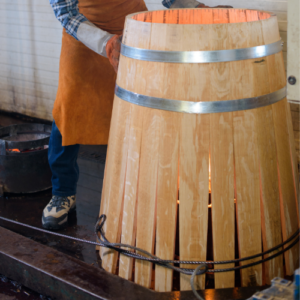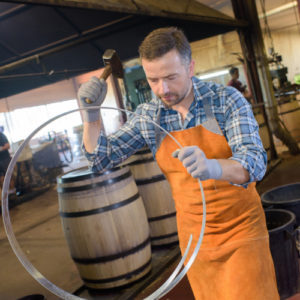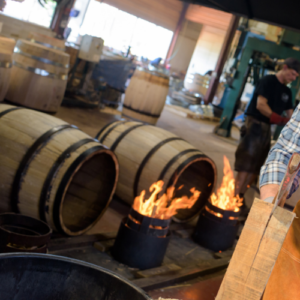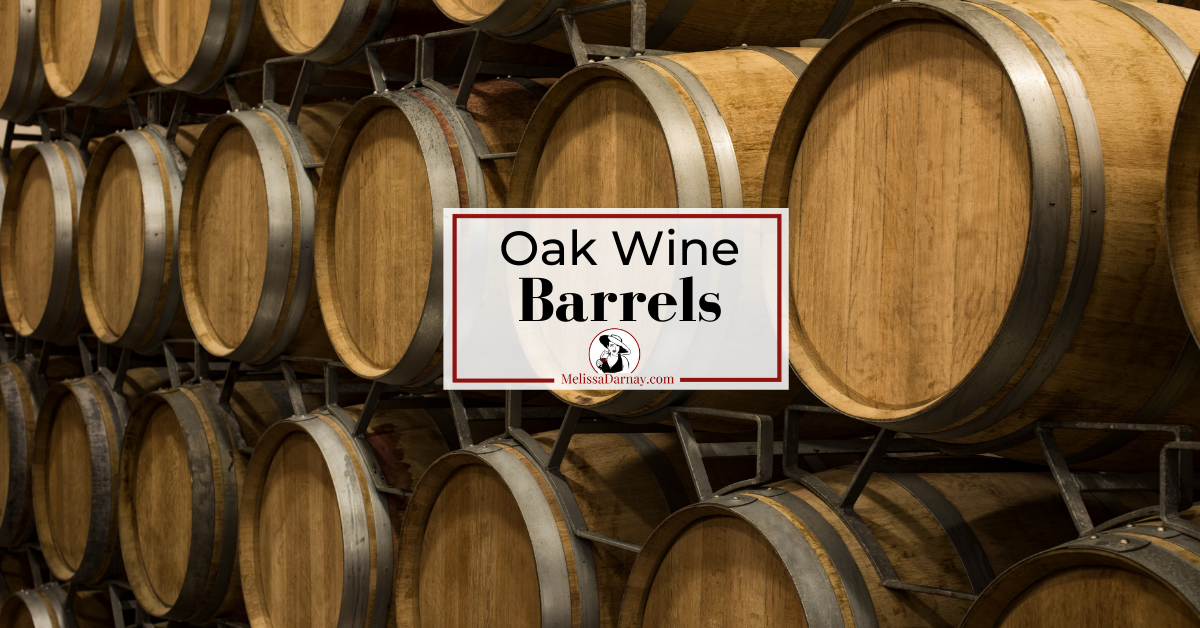Wine has been around for thousands of years. Before glass bottles were invented, wood barrels were used to store, transport and sell wine. Although bags and wooden crates were cheaper to produce, workers could move barrels more easily, even up and down gangplanks or stairs.
The Celts probably invented oak barrels in about 350 BC. Over the next two millennia, barrels became the favored method of transporting and storing bulk goods. Because barrels could be rolled and stacked, they transported everything from wine and whiskey to nails and gold coins.
Wine merchants eventually realized that wine tasted better after a long sea journey. This led to them to experiment with new versus used oak barrels.
Choosing the Right Wood for Wine Barrels
Because barrels need to be watertight, a cooper–the artisan who makes the wine barrel–requires a great amount of expertise. It takes a skilled cooper an entire day to make one wine barrel, which is one of the reasons oak barrels are so expensive.
The first thing a cooper does is to select the wood. Oak is the wood of choice as it adds complementary flavors to the wine. The oak needs to come from a cold-weather climate as trees grow slower when it’s. cold, creating a tighter grain. This in turn releases the oak flavors more slowly into the wine, giving the wine a more integrated flavor.
How Oak Wine Barrels Are Made
Oak planks, called staves, make up the body of the barrel. The staves need to be wider in the center and narrower at the ends. In addition, the cooper must cut the wood with the grain. Otherwise, the pores that once gave the tree nutrition will become a route for wine to leak out of the barrel. It takes a master cooper years to master this skill.

Heat and humidity work together to bend the staves, forming an oak wine barrel.
For a wine barrel with a diameter of 56 centimeters, 25 to 30 staves are used to create one end of the barrel, and they are lashed together with a metal hoop. With one end tightened and the other end still open, the barrel looks like an old-fashioned hoop skirt. At this point, the inside of the barrel is wet and a fire is lit inside of it. Although the flames never touch the wood, the heat and humidity make the wood pliable enough to bend, although it takes about 2 hours of heating and tightening to get the bottom of the staves bent into the shape of a barrel.

A cooper is making a custom metal ring for an oak wine barrel.
The Barrel’s Degree of Toast
With the ends of the barrel open, the cooper lights a small fire that singes the edges of the wood on the inside of the barrel. This “toasting” of the staves is what gives the wine so much flavor. But coopers need to use caution because too much toasting can overpower the flavor of the wine.
Wine barrels can have light, medium, or heavy toasting. The winemaker must determine which level of toasting is the right fit for each wine.

Fire toasts the inside of each oak wine barrel.
How Oak Wine Barrels Improve the Flavor of Wine
Wine is no longer sold or transported in oak barrels. The only job of the oak wine barrel is to improve the flavor of the wine.
A winemaker needs to make a variety of choices with regard to barrel-aging wine that can impact flavor, style and price. Some of the things that can affect the flavor of wine include:
- The type of oak used
- How much the inside has been toasted
- How often it has been used
- The length of time the wine will age inside of the barrel.
American Oak Versus French Oak
FLAVOR
American oak barrels imparts a sweeter flavor and makes the wine softer. It adds flavors of vanilla, coconut and baking spices, such as nutmeg and cinnamon.
French oak makes the wine more austere and adds flavors of vanilla, chocolate, mocha and coffee beans. French oak is less porous, which means it takes the wine more time to soften, resulting in a more structured and tannic wine.
COST
An average cost for a new 60-gallon American Oak barrel is about $440 after shipping, whereas the same size new French oak barrel is about $1,000. Each barrel holds about 304 wine bottles worth of wine. This equals about $1 of hard cost for American Oak and $3 for French oak.
This doesn’t like a lot, but it’s a significant portion of the winemaker’s budget in all but luxury wine. A less expensive option is to use new oak for the winery’s premium wine and then reuse the oak barrels a few times for the less expensive labels.
New Oak Versus Used Oak
New oak imparts more flavor into the wine. Think of a new teabag. When you first use it, it creates a dark cup of tea. However, each time you reuse a teabag, the tea becomes weaker, with less flavor and fewer tannins.
If money were no object, winemakers would frequently use new oak. Most wineries use new oak barrels three times. Once the barrel is no longer able to impart its flavors into the wine, it is considered “neutral” and sold to less prosperous wineries or whiskey distilleries. Other wineries that make less expensive wine may fill their barrels as many as eight times before upcycling them as planters or furniture.
How Long Should Wine Age in Barrels?
This is another fight between the winemaker and accountant. Typically, premium wines spend more time in oak barrels, as this added aging creates a smooth and complex wine. Wines with smaller budgets can’t afford two or three years in a barrel. When considering expenses, the overhead costs of storing barrels must be taken into consideration. Even large wineries have a limited amount of storage space. A long aging cycle means that other wine can’t use that barrel or that cellar space.
The cost of a barrel is more than just what you pay a cooper, though. Longer barrel aging means greater evaporation, which translates into fewer bottles of wine to sell. Wineries experience two to ten percent of evaporation per year. For high-end wines, this creates a more concentrated wine. In less expensive brands, evaporation is an expense that can’t be recouped.
Why do winemakers use oak barrels? To make the wine taste better. But like master chefs, there is no one-size-fits-all in winemaking. A winemaker’s many decisions about oak barrels impact taste, quality and price.





0 Comments